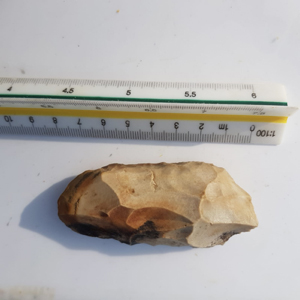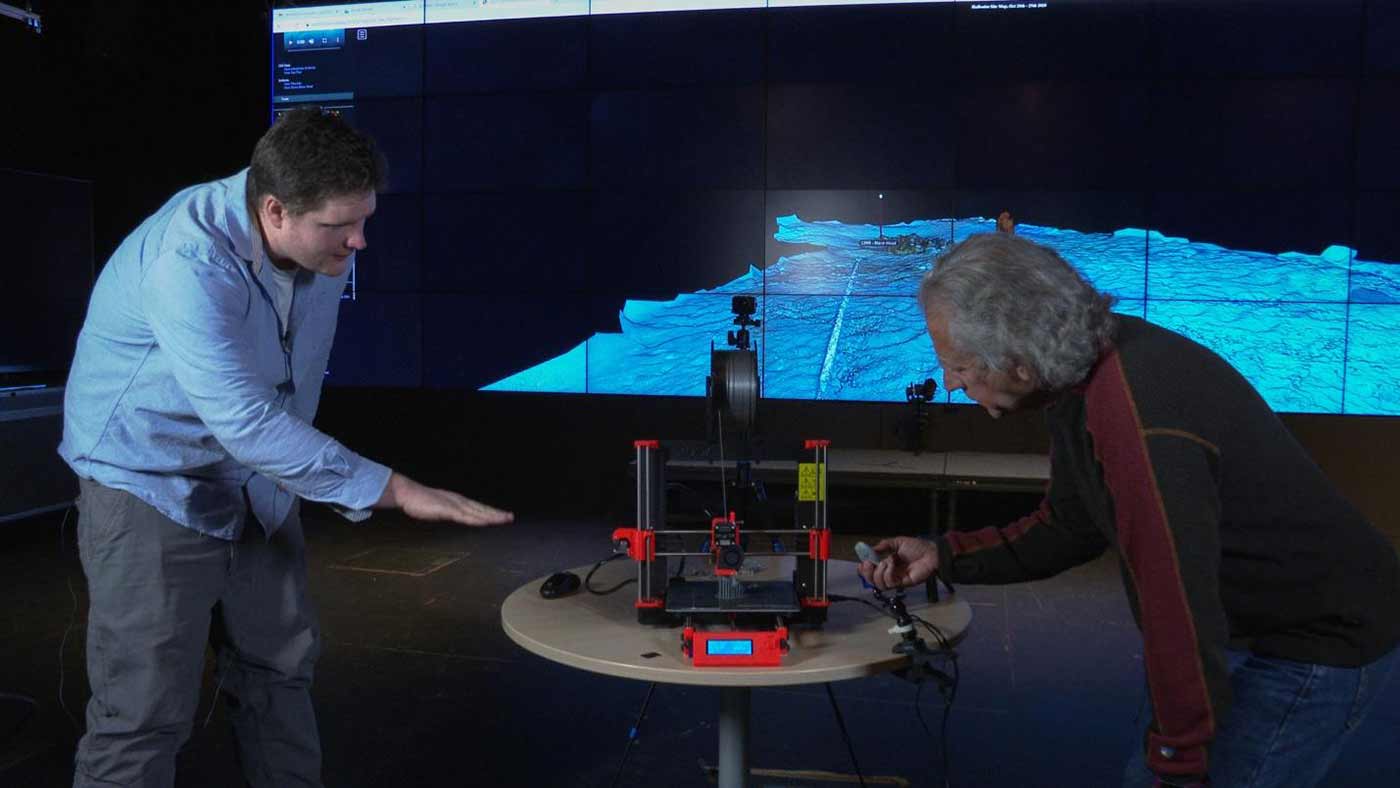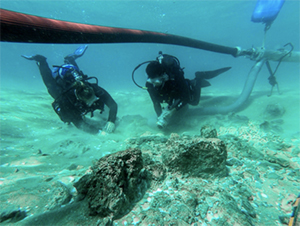By:
- Xochitl Rojas-Rocha
Published Date
By:
- Xochitl Rojas-Rocha
Share This:

Roey Nickelsberg, a graduate student with the University of Haifa in Haifa, Israel, examines a Neolithic pottery shard found at the HaBonim dig site. Photo by Amir Yurman/University of Haifa.
Archaeologists Explore Secrets of Neolithic Village off Israel’s Coast—Under COVID-19
UC San Diego archaeologist and Qualcomm Institute (QI) affiliate Thomas Levy and Assaf Yasur-Landau of the University of Haifa in Haifa, Israel and their teams have completed a combined physical and virtual excavation of a Neolithic underwater settlement off Israel’s Carmel coast. The expedition could reveal secrets about prehistoric social evolution, climate and environmental change from more than 8,000 years ago.
In accordance with social distancing measures, the UC San Diego team used remote technology developed in QI to join their Israeli collaborators in a three-week excavation of the site from the safety of home.

A recovered Neolithic flint adze, an early tool possibly used for woodworking. Photo by Assaf Yasur-Landau/University of Haifa.
“We had planned to be in the field with Assaf and his team in October, but with the COVID-19 pandemic, we could not travel,” said Levy, director of the Center for Cyber-Archaeology and Sustainability at QI and co-director of the Scripps Center for Marine Archaeology. “The challenge was to find a way for our UC San Diego team to collaborate with our Israeli colleagues in a meaningful and useful way, while stuck in southern California.”
The team is currently in the process of using QI’s cutting-edge visualization facilities to analyze new artifacts and highly-detailed 3D maps of the site for posterity and sampling sediment to study the ancient environment.
Adding new finds to a wealth of knowledge
Science divers led by Yasur-Landau at the University of Haifa’s Leon Recanati Institute for Maritime Studies carried out the dig in the surf-zone 30 kilometers south of Haifa. The team uncovered the remains of settlement walls, discovered rich archaeological finds such as flint implements and shards of early pottery and gathered photogrammetric imagery and video footage for a detailed 3D map.
QI researchers are now leveraging the institute’s SunCAVE, the nation’s highest-resolution walk-in virtual reality facility, to visualize the site in 3D with the ultimate goal of replicating archaeological features in-situ for further exploration. The effort unites international talents in archaeology, science diving, scientific visualization and 3D-modeling and printing.
“With the power of the SunCAVE, we can explore this prehistoric site any time right here at the UC San Diego campus,” said Levy. “We’ll have the ability to study the dig in great detail, especially as we uncover more of the site and learn about these ancient peoples’ way of life.”

Scott Mcavoy (left), media specialist at the Geisel Library, prints a 3D model of a Neolithic flint tool found at the HaBonim dig site while Qualcomm Institute's Tom Levy (right) looks on. Photo by Hector Bracho/QI.
The Neolithic was a key period for the formation of Mediterranean farming communities as well as a time when climate changes and rising sea levels required new, innovative modes of human adaptation.
As the scientists learn more about this period of social evolution, they will add their discoveries to an existing well of knowledge stored in the digital archives at QI, the Geisel Library and the University of Haifa. The researchers will use the Pacific Research Platform, a data-sharing “superhighway” that provides a seamless research platform to encourage collaboration on a wide range of data-intensive fields and projects. The archives offer researchers a look at culturally significant sites like the HaBonim submerged settlement and represent a dynamic record for future study.
“Partnering with QI has significantly pushed forward the transition to next generation on-site recording and real-time big data sharing methods in underwater archaeology at the University of Haifa,” said Yasur-Landau. “Collaborative projects in the future will be based on the lessons learnt in this very successful project.”
Despite travel restrictions posed by COVID-19, collaborating remotely has also had surprise benefits. With the support of QI research and development engineer Joel Polizzi, the audio-visual team at QI, and Meir Edrey, professional director of the Leon Recanati Institute for Maritime Studies at the University of Haifa, Levy and colleagues worked around COVID-19 travel restrictions and a time difference that resulted in a round-the-clock effort. Overcoming the obstacle has afforded the team lessons in best practices for remote collaboration.
A new age in archaeology

Science divers with the University of Haifa use an underwater dredge system to vacuum away sand from the ruins of a settlement wall. Photo by Amir Yurman/University of Haifa.
The excavation is part of the SCMA Koret-Israel Project, a collaboration between UC San Diego’s Scripps Center for Marine Archaeology and the University of Haifa’s Leon Recanati Institute for Maritime Studies. The project began this year with a gift of more than $1.3 million from the Koret Foundation to support research in marine archaeology.
Other collaborators at UC San Diego include Scripps Institution of Oceanography, the Department of Anthropology and Geisel Library. Sarah Lantos, Brigid Clark and other graduate students at the University of Haifa were involved in excavating and recording footage at the submerged site.
Share This:
You May Also Like
Stay in the Know
Keep up with all the latest from UC San Diego. Subscribe to the newsletter today.



